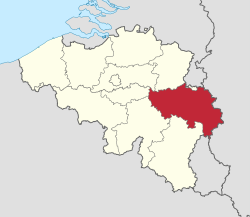Liège (province)
Liège [4] (French: Liège, German: Lüttich, Dutch: Luik, Kölsch: Lüttish, Limburgish: Luuk, Luxembourgish: Léck, Walloon: Lidje) is the easternmost province of the Walloon Region, in Belgium. Its capital is the city of Liège.
Liège
| |
|---|---|
 | |
| Coordinates: 50°38′N 05°34′E / 50.633°N 5.567°E | |
| Country | |
| Region | |
| Capital (and largest city) | Liège |
| Government | |
| • Governor | Hervé Jamar (MR) |
| Area | |
| • Total | 3,857 km2 (1,489 sq mi) |
| Population (1 January 2022)[2] | |
| • Total | 1,110,989 |
| • Density | 288/km2 (750/sq mi) |
| HDI (2019) | 0.903[3] very high · 8th of 11 |
| Website | Official site |
It is an area of French and German ethnic groups. Most of its inhabitants speak French and a minority of them speak German.
History
changeThe present province comes from a department created by the French government in the late eighteenth century, the Department of Ourte. In 1815, after the defeat of Napoleon, the eastern part (Eupen, Malmedy, Saint-Vith and four other German municipalities) was given to the Prussian empire.[5]
While maintaining the French administrative borders, King William I of the Netherlands gave back the more traditional names of the provinces instead of the names used by the French. He named the province as Liège, remembering the old principality of Liège, although the region did not correspond much to the old principality.
In 1919, after the Prussian defeat, the cantons Eupen, Malmedy and Saint-Vith were again part of the province of Liège.[5]
Geography
changeThe province of Liège is in southeastern Belgium and borders on (clockwise from the North) the Netherlands, Germany, Luxembourg and in Belgium the provinces of Luxembourg, Namur, Walloon Brabant (Wallonia), and those of Flemish Brabant and Limburg (Flanders).
The province has an area of 3,857 km2 (1,489 sq mi) and a population of about 1,111,000 in 2022. The province is divided into four arrondissements (arrondissementen in Dutch) with 84 municipalities, 75 French-speaking municipalities and 9 German-speaking municipalities.
With 694 m (2,277 ft), the Signal de Botrange is the highest point of the province and of Belgium.[6] It is in Waimes, Verviers district.[7]
Rivers
changeThe main river is the Meuse (Dutch: Maas) river; its source is in France, in Champagne-Ardenne and then flows through Belgium by the provinces of Namur and Liège. After 950 km (590 mi), it flows into the North Sea.[8]
Other rivers in the province are:[8]
- Ourthe, tributary of the Meuse.
- Vesdre, also a tributary of the Meuse.
- Amblève, tributary of the Ourthe.
- Warche, tributary of the Amblève.
- Geer, another tributary of the Meuse.
Administrative divisions
changeThe province of Liège is divided into 4 arrondissements (Huy, Liège, Verviers and Waremme) and a total of 84 municipalities.
(names are in the following table)
| Huy | Liège | Verviers | Waremme |
|---|---|---|---|
|
|
Population by arrondissement
changePopulation x 1,000 (on 1 January since 1980).[9]
| Arrondissement | 1970 | 1980 | 1990 | 2000 | 2010 | 2020 |
|---|---|---|---|---|---|---|
| Huy | 94 | 88 | 93 | 100 | 108 | 114 |
| Liège | 618 | 612 | 590 | 586 | 604 | 626 |
| Verviers | 240 | 245 | 252 | 266 | 280 | 288 |
| Waremme | 58 | 61 | 63 | 68 | 76 | 82 |
| Province of Liège | 1,009 | 1,006 | 998 | 1,019 | 1,068 | 1,110 |
References
change- ↑ "Bodembezetting volgens het Kadasterregister". statbel.fgov.be.
- ↑ "Structuur van de bevolking". statbel.fgov.be.
- ↑ "Sub-national HDI - Area Database - Global Data Lab".
- ↑ Official names are Province de Liège (French) and Provinz Lüttich (German).
- ↑ 5.0 5.1 "Histoire". Province de Liège (in French). Retrieved 2 September 2013.
- ↑ "Signal de Botrange". Peakbagger.com. Retrieved 2 September 2013.
- ↑ "84 communes". Province de Liège (in French). Retrieved 2 September 2013.
- ↑ 8.0 8.1 "Géographie". Province de Liège (in French). Retrieved 2 September 2013.
- ↑ Institut national de statistique - Direction générale Statistique et information économique
Other websites
change- Official web site of the Liège province Archived 2024-01-31 at the Wayback Machine (in French)
- Bureau des Relations Extérieures de la Province de Liège Archived 2005-02-09 at the Wayback Machine (in French, Dutch, German and English)

